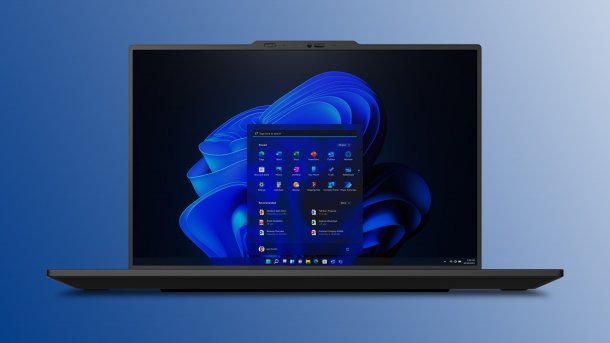The fastest RAM no longer has to be soldered
Lenovo's Thinkpad P1 Gen 7 has fast LPDDR5X memory, which can be replaced for the first time. New modules are used for this.

Lenovo's Thinkpad P1 Gen 7 with removable LPDDR5X memory. Unfortunately, there are no pictures of the inner workings.
(Bild: Lenovo)
Lenovo is updating its mobile workstations with the latest Intel processors and graphics chips from Nvidia. The Thinkpad P1 Gen 7 stands out, as it is the first notebook to feature a technical innovation: it uses so-called Compression Attached Memory Modules of type LPCAMM2.
The modules contain LPDDR5X-7467 memory chips, which achieve a transfer rate of almost 120 GByte/s on 128 data lines (bits). Previously, these had to be soldered to the mainboard to ensure the necessary signal quality. Manufacturers of particularly flat notebooks also prefer this design because the previous SO-DIMM standard requires more space. They are also significantly slower with clock speeds up to DDR5-5600 (overclocking modules up to DDR5-6400).
(Bild: Micron)
CAMMs avoid these problems. Unlike SO-DIMMs, they are not inserted into a contact strip; instead, they are screwed onto a contact surface from above. Screwing improves the contact, and the principle also saves space compared to plugged-in modules.
Dell played a leading role in the development of CAMM. The JEDEC group of companies has defined the standard as CAMM2 for all manufacturers. LPCAMM2 is now simply a designation for modules that use lower-power memory chips (LPDDR). Lenovo relies on modules from the manufacturer Micron, which are available with capacities from 16 to 64 GB. A single LPCAMM2, which is connected with the full 128 bits, fits into the Thinkpad P1 Gen 7.
High-end notebook as a pioneer
Otherwise, the Thinkpad P1 Gen 7 offers everything you would expect from a mobile workstation: Intel's Core Ultra processors up to the Core Ultra 9 185H, Nvidia's mobile GeForce RTX 4070 or the professional version RTX 3000 Ada, up to 8 TByte SSD storage (PCIe 4.0), two Thunderbolt 4 ports along with USB, Wi-Fi 7 and high-resolution 16:10 displays. There is a choice of IPS and OLED variants, the latter with 3840 × 2400 pixels, touch support, 400 cd/m² and full DCI-P3 coverage.
Lenovo Thinkpad P1 Gen 7 (10 Bilder)

With prices starting at 2450 euros (possibly excluding VAT), the Thinkpad P1 Gen 7 is of interest to very few people. However, it raises hopes that even flat notebooks could become more repair- and upgrade-friendly in the future, thanks to exchangeable memory modules. Sales of the Lenovo notebook are set to begin in June 2024.
Empfohlener redaktioneller Inhalt
Mit Ihrer Zustimmmung wird hier ein externer Preisvergleich (heise Preisvergleich) geladen.
Ich bin damit einverstanden, dass mir externe Inhalte angezeigt werden. Damit können personenbezogene Daten an Drittplattformen (heise Preisvergleich) übermittelt werden. Mehr dazu in unserer Datenschutzerklärung.
(mma)